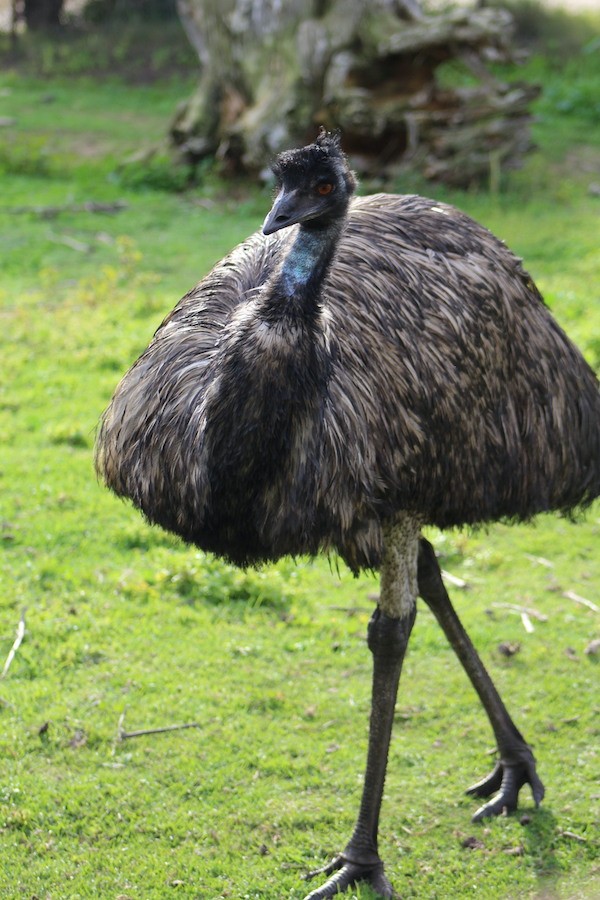Emus are truly remarkable birds. Maybe you’ve encountered one at a zoo or wildlife park and been captivated by their size and unique appearance. These impressive, prehistoric-looking creatures aren’t just confined to zoos, though! Across the United States and in other parts of the world, people are increasingly keeping emus as pets. If the idea of owning a pet emu has piqued your interest, you’ve come to the right place. This comprehensive guide will walk you through everything you need to know about emu ownership, helping you decide if these fascinating birds are the right pet for you.
Understanding the Emu
Before diving into pet ownership, let’s understand what exactly an emu is. The emu (Dromaius novaehollandiae) is the second-largest living bird in the world, after its cousin, the ostrich. Native to Australia, emus belong to a group of flightless birds known as ratites, which also includes ostriches, rheas, cassowaries, and kiwis.
Emus are easily recognizable by their impressive stature. They boast long necks and powerful legs, perfectly adapted for running. While their wings are vestigial, their legs propel them to speeds of up to 30 miles per hour. Adult emus can reach heights of up to 6 feet and weigh between 100 and 150 pounds. If you’re seeking a pet with a long lifespan, emus are a great choice, often living for 30 years or even longer with proper care.
Historically, emus have been domesticated for various purposes, including as a source of meat, oil, and leather. However, their unique personalities and relatively docile nature (especially when raised correctly) have also made them popular as pets. In the United States, the USDA classifies emus as livestock. This classification means that emu ownership is subject to certain regulations, particularly concerning housing and care, to ensure their well-being and prevent the spread of disease. It’s crucial to research both federal and local regulations in your specific area before considering getting an emu. Zoning laws and homeowner association rules might also impact your ability to keep an emu.
For those interested in breeding, emus are typically kept in pairs. A male and female pair can produce a clutch of eggs annually, ranging from 20 to 40 large, striking blue-green eggs per season. Interestingly, the male emu takes on the primary role of incubation. Emu eggs are substantial in size, equivalent to about 10-12 chicken eggs, and are a delicacy in some culinary circles.
If the idea of a unique, long-lived pet like an emu is still appealing, keep reading to learn about the practicalities of housing, feeding, and raising these magnificent birds.
Setting Up the Perfect Emu Habitat
Providing adequate housing is paramount for the health and happiness of your pet emu. Space is a primary consideration. While breeders often keep emu pairs in enclosures of around 1,000 square feet, providing more space is always beneficial. For truly content emus, consider allocating even more room to roam and explore. An acre of land can comfortably accommodate approximately 10 emu pairs. Emus prefer natural ground to concrete or other artificial surfaces, enjoying scratching and pecking at the earth.
Fencing is another critical aspect of emu housing. Given their height, a minimum fence height of 6 feet is essential to securely contain these birds. Emus are surprisingly adept jumpers and climbers, so “no-climb” fencing or chain-link fencing is highly recommended. Ensure fence posts are robust enough to withstand potential pressure from the birds.
Emus are remarkably adaptable to various climates. Their dense, fluffy feathers provide excellent insulation, enabling them to tolerate temperatures well below freezing by puffing up their plumage to trap warm air. While they can withstand temperatures as low as 23 degrees Fahrenheit, prolonged exposure to extreme cold should be avoided.
For most climates, a simple three-sided shelter is sufficient. Structures like the Run-In or Camp Alcove provide ample protection from the elements. Adding pine shavings or straw bedding within the shelter enhances comfort. These open shelters are advantageous as they offer refuge from both cold and heat, allowing emus to utilize them year-round.
In regions with harsh winters, a more substantial shelter like a barn is advisable to provide a warm, cozy retreat during the coldest periods. Ensure the shelter has doorways tall enough for easy emu access. Deep bedding and an infrared heating source can further enhance warmth in extremely cold conditions. However, even in winter, emus should not be confined indoors constantly. They are active birds that need space to move around. A larger structure like the Weekender can offer both open and enclosed shelter options within a single building. During cold weather, emus increase their metabolic rate to stay warm, so providing supplemental food during winter months is a good practice.
Observing how other emu owners set up their enclosures can be helpful. For example, the Renaud farm, customers of Jamaica Cottage Shop, successfully keep emus alongside geese, ducks, and chickens. Watching videos of established emu enclosures can provide valuable insights for setting up your own.
Nourishing Your Emu: Diet and Hydration
A balanced diet is crucial for maintaining the health and vitality of your pet emu. Ideally, an emu’s diet should consist of 15% to 20% protein. This protein requirement is easily met with specialized ratite pellets, commercially formulated feeds specifically designed for birds like emus and ostriches. Some owners also successfully use high-quality chicken feed or dog food as a primary dietary component. On average, expect an adult emu to consume about 1.5 pounds of feed per day. It’s important to avoid diets primarily based on grains, especially corn kernels. Corn is difficult for emus to digest and lacks sufficient nutritional value.
Supplementing your emu’s diet with a variety of foods is beneficial for both nutritional diversity and enrichment. Alfalfa pellets are an excellent source of fiber and can be used as a regular supplement. Emus are surprisingly omnivorous and can consume many of the same foods humans eat, making food scraps a valuable and sustainable addition to their diet. Fruit and vegetable scraps are particularly well-suited as healthy snacks. While emus can also eat meat, it should be offered sparingly as an occasional treat, not a dietary staple.
Water is absolutely essential for emus. They require constant access to fresh, clean water. Being active animals, emus can drink up to five gallons of water per day, especially in warmer weather. Placing food and water containers within the shelter you provide can help keep them clean and shaded.
Raising and Socializing Your Pet Emu
Sourcing your emu from a reputable breeder is crucial, especially if you are seeking a bird for companionship. Organizations like the American Emu Association (AEA) can be valuable resources for finding reputable breeders in your area. Researching breeder reputations beforehand is always recommended.
For those wanting a particularly tame and human-friendly pet emu, acquiring a very young chick (1-7 days old) or hatching eggs yourself is the best approach. Raising emus from chicks is often recommended for first-time emu owners. Adult emus, while generally docile, are large and powerful animals. Young chicks raised by humans are more likely to imprint on their owners and develop into gentler, more manageable pets. Interestingly, male emus are often reported to be slightly calmer and more easily tamed than females.
Baby emus hatched and raised by humans will often exhibit imprinting behavior, following their owners closely. Very young emu chicks can even be raised indoors initially. A ratite crumble diet is ideal for young chicks, presented in a bowl with shiny objects to attract their attention to the food. Emu chicks grow rapidly and will be ready to transition to their outdoor enclosure within a few weeks. While young, they are vulnerable to predators, so ensuring a secure enclosure is vital. Emus reach their adult size relatively quickly, around 5-6 months of age, becoming more self-sufficient.
Photo by Christian Bass on Unsplash
Like any pet, emus can experience health issues. It’s important to have access to veterinary care. Monitor your emus for signs of illness, such as decreased appetite, weight loss, diarrhea, droopy eyes, or nasal discharge. If you observe any of these signs, consult a veterinarian experienced with livestock or exotic animals. Many such vets offer farm or house calls, eliminating the need to transport your large birds. If interstate travel with your emu is necessary, a health certificate and veterinary check are typically required.
Conclusion: Is a Pet Emu Right for You?
Owning a pet emu can be an incredibly rewarding experience for the right person. If you have ample space, a passion for unique animals, and the dedication to meet their specific needs, an emu could be an ideal pet. However, responsible pet ownership always begins with careful planning. Before acquiring an emu, thoroughly research all aspects of their care, local regulations, and the long-term commitment involved. Purchasing an emu is a significant investment, and ensuring you are prepared for emu ownership is crucial for both your well-being and the bird’s.
By providing proper housing, nutrition, care, and socialization, you can enjoy the companionship of a truly majestic and unique pet for many years to come. And who knows, if you choose to build your emu’s habitat with a Jamaica Cottage Shop structure, perhaps you’ll share some photos of your amazing setup!


